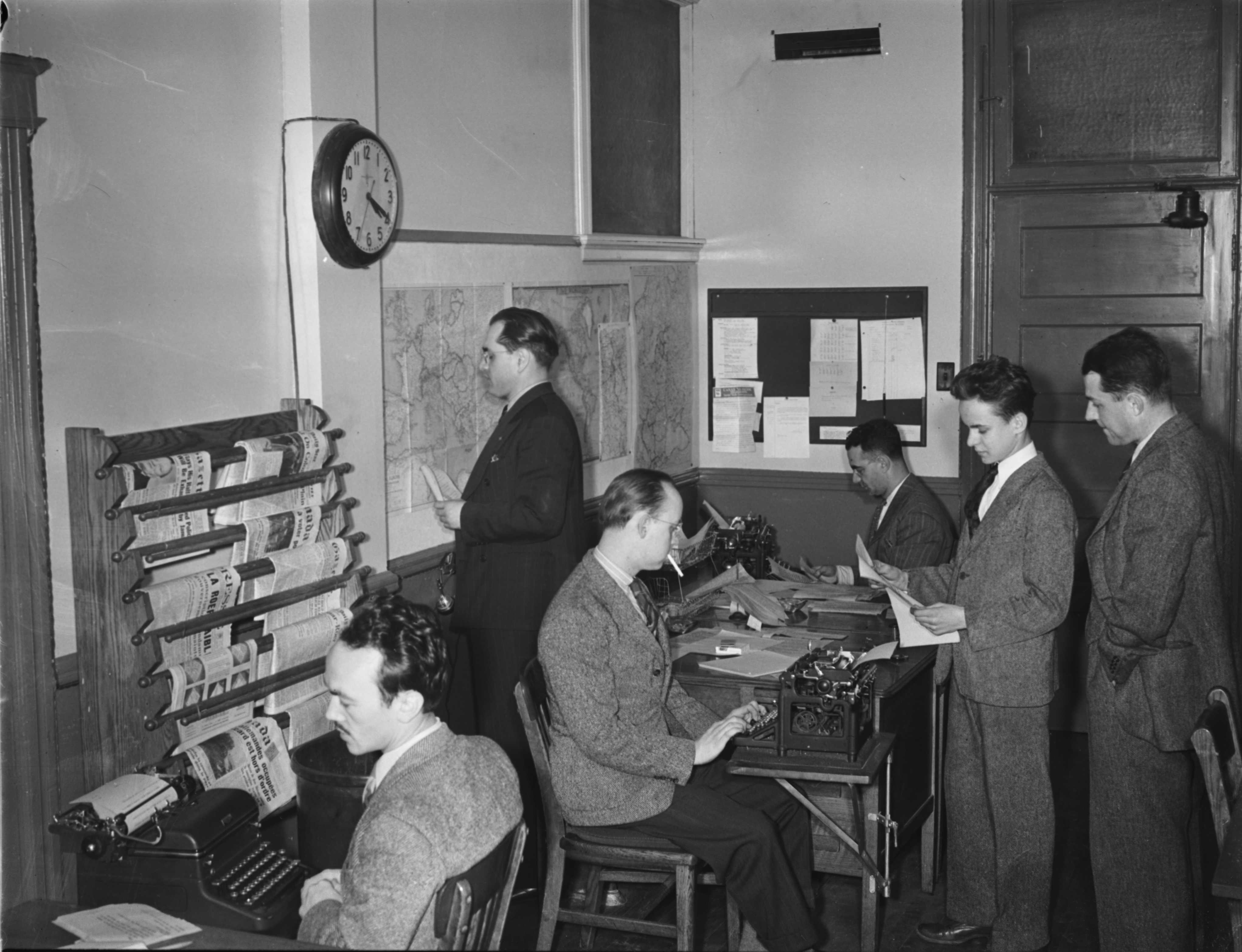|
Canadian Association Of Broadcasters
The Canadian Association of Broadcasters (CAB) is a trade association representing the interests of commercial radio and television broadcasters in Canada. It is co-located with the Canadian Broadcast Standards Council in Ottawa. It was first established in 1925, with a goal to lobby for Canadian copyright law to contain provisions for the distribution of royalties for music played by radio stations. Following the establishment of the Canadian Broadcasting Corporation, which served as both a broadcaster and regulator, the CAB lobbied for the establishment of an independent regulator of broadcasting in Canada, a goal achieved in 1958 with the formation of the Board of Broadcast Governors. The CAB worked with the BBG to assist in the establishment of private radio and television broadcasters. In the 1970s, the CAB lobbied against attempts by the BBG's successor, the CRTC, to implement policies for Canadian content. In 1998, the CAB established the Canadian Radio Music Awards. ... [...More Info...] [...Related Items...] OR: [Wikipedia] [Google] [Baidu] |
Trade Association
A trade association, also known as an industry trade group, business association, sector association or industry body, is an organization founded and funded by businesses that operate in a specific Industry (economics), industry. Through collaboration between companies within a Business sector, sector, a trade association coordinates public relations activities such as advertising, education, publishing and, especially, lobbying and political action. Associations may offer other services, such as producing conferences, setting industry standards, holding networking or charitable events, or offering classes or educational materials. Many associations are non-profit organizations governed by bylaws and directed by officers who are also members. (FEC: Solicitable Class of Trade Association, Library of Congress). In countries with a social market economy, the role of trade associations is often taken by employers' organizations, which also take a role in social dialogue. Political in ... [...More Info...] [...Related Items...] OR: [Wikipedia] [Google] [Baidu] |
Board Of Broadcast Governors
The Board of Broadcast Governors (BBG) was an arms-length Government of Canada agency. It was created in 1958 by amending the ''Broadcast Act'' to regulate television and radio broadcasting, originally taking over that function from the CBC. The BBG was replaced by the Canadian Radio-television and Telecommunications Commission in the 1968 amendments to the 1958 Act. Board The board consisted of 12 members appointed by the federal government: * 3 full-time members * 9 part-time The head of the board was the Governor. There had only been two Chairmen: * Dr. Andrew Stewart November 10, 1958 – March 18, 1968 * Pierre Juneau March 18–31, 1968 History In 1957, the Progressive Conservative party intended to change the makeup of the Canadian Broadcast system. Up to that point, the Canadian Broadcasting Corporation The Canadian Broadcasting Corporation (), branded as CBC/Radio-Canada, is the Canadian Public broadcasting, public broadcaster for both radio and televisio ... [...More Info...] [...Related Items...] OR: [Wikipedia] [Google] [Baidu] |
Television Organizations In Canada
Television (TV) is a telecommunications, telecommunication media (communication), medium for transmitting moving images and sound. Additionally, the term can refer to a physical television set rather than the medium of signal transmission, transmission. Television is a mass media, mass medium for advertising, entertainment, news, and sports. The medium is capable of more than "radio broadcasting", which refers to an audio signal sent to radio receivers. Television became available in crude experimental forms in the 1920s, but only after several years of further development was the new technology marketed to consumers. After World War II, an improved form of black-and-white television broadcasting became popular in the United Kingdom and the United States, and television sets became commonplace in homes, businesses, and institutions. During the 1950s, television was the primary medium for influencing public opinion.Diggs-Brown, Barbara (2011''Strategic Public Relations: Audi ... [...More Info...] [...Related Items...] OR: [Wikipedia] [Google] [Baidu] |
Organizations Established In 1926
An organization or organisation (Commonwealth English; see spelling differences) is an entity—such as a company, or corporation or an institution (formal organization), or an association—comprising one or more people and having a particular purpose. Organizations may also operate secretly or illegally in the case of secret societies, criminal organizations, and resistance movements. And in some cases may have obstacles from other organizations (e.g.: MLK's organization). What makes an organization recognized by the government is either filling out incorporation or recognition in the form of either societal pressure (e.g.: Advocacy group), causing concerns (e.g.: Resistance movement) or being considered the spokesperson of a group of people subject to negotiation (e.g.: the Polisario Front being recognized as the sole representative of the Sahrawi people and forming a partially recognized state.) Compare the concept of social groups, which may include non-organiza ... [...More Info...] [...Related Items...] OR: [Wikipedia] [Google] [Baidu] |
Professional Associations Based In Canada
A professional is a member of a profession or any person who works in a specified professional activity. The term also describes the standards of education and training that prepare members of the profession with the particular knowledge and skills necessary to perform their specific role within that profession. In addition, most professionals are subject to strict codes of conduct, enshrining rigorous ethical Ethics is the philosophical study of moral phenomena. Also called moral philosophy, it investigates normative questions about what people ought to do or which behavior is morally right. Its main branches include normative ethics, applied e ... and moral obligations. Professional standards of practice and ethics for a particular field are typically agreed upon and maintained through widely recognized professional associations, such as the Institute of Electrical and Electronics Engineers, IEEE. Some definitions of "professional" limit this term to those professions ... [...More Info...] [...Related Items...] OR: [Wikipedia] [Google] [Baidu] |
Canadian Broadcast Hall Of Fame
The Canadian Broadcast Hall of Fame, started in 1982, recognizes Canadians in broadcasting or entertainment related industries who have "achieved outstanding success in helping raise industry standards from a material or humanitarian standpoint." The CAB Hall of Fame honours, in perpetuity, men and women whose contributions had demonstrated an extraordinary commitment to innovation, development and maintaining the highest standards of excellence in broadcasting generally, particularly in Canada. Candidates are nominated annually by Canada's five broadcasting associations and the executive committee of the Canadian Association of Broadcasters ("CAB"). The name of each inductee is inscribed in bronze on the Hall of Fame plaque at the CAB offices in Ottawa. Personalized plaques are also presented to either the inductees themselves or to their families. Inductees include (partial list) * Warren Barker (broadcaster), journalist and news director of CKNW from 1959-1991 * Gerry Acton ... [...More Info...] [...Related Items...] OR: [Wikipedia] [Google] [Baidu] |
Canadian Communications Foundation
The Canadian Communications Foundation (CCF) was a Canadian nonprofit organization which documented the history of broadcasting in Canada, particularly radio and television networks, programs and broadcasters. The organization was established in 1967 and announced that it would begin wrapping up its work in 2023. Since 1995, the organization distributed its collection via its website. The CCF was established in 1967 by the Canadian Association of Broadcasters. Its mission: to "commemorate throughout Canada the development of electronic communications". By 2020, the foundation started to wind down as its original mission was largely accomplished. The foundation's collected materials included interviews with broadcasters who had helped shape Canada's broadcast industry, a history of television stations, a Hall of Fame for broadcasters, and a collection of research articles on broadcasting in Canada. See also *Canadian Association of Broadcasters The Canadian Association of Bro ... [...More Info...] [...Related Items...] OR: [Wikipedia] [Google] [Baidu] |
Vertical Integration
In microeconomics, management and international political economy, vertical integration, also referred to as vertical consolidation, is an arrangement in which the supply chain of a company is integrated and owned by that company. Usually each member of the supply chain produces a different Product (business), product or (market-specific) service, and the products combine to satisfy a common need. It contrasts with horizontal integration, wherein a company produces several items that are related to one another. Vertical integration has also described management styles that bring large portions of the supply chain not only under a common ownership but also into one corporation (as in the 1920s when the Ford River Rouge complex began making much of its own steel rather than buying it from suppliers). Vertical integration can be desirable because it secures supplies needed by the firm to produce its product and the market needed to sell the product, but it can become undesirable wh ... [...More Info...] [...Related Items...] OR: [Wikipedia] [Google] [Baidu] |
Canadian Radio Music Awards
The Canadian Radio Music Awards is an annual series of awards presented by the Canadian Association of Broadcasters that was part of Canadian Music Week The Departure Festival + Conference, formerly known as Canadian Music Week, is an industry conference and music festival held in Toronto, Ontario, Canada.David Friend"Canadian Music Week buyers rename event Departure Festival, expand its scope" .... The award show began in 1998. 2016 Complete list of 2016 Canadian Radio Music Awards winners 2017 Complete list of 2017 Canadian Radio Music Awards winners 2018 Complete list of 2018 Canadian Radio Music Awards winners References External linksCRMA Awards at Canadian Music Week {{Music awards Canadian music awards Canadian radio awards ... [...More Info...] [...Related Items...] OR: [Wikipedia] [Google] [Baidu] |
Canadian Content
Canadian content (abbreviated CanCon, cancon or can-con; ) refers to the Canadian Radio-television and Telecommunications Commission (CRTC) requirements, derived from the Broadcasting Act of Canada, that radio and television broadcasters (including cable and satellite specialty channels, and since the passing of the '' Online Streaming Act'', Internet-based video services) must produce and broadcast a certain percentage of content that was at least partly written, produced, presented, or otherwise contributed to by persons from Canada. CanCon also refers to that content itself, and, more generally, to cultural and creative content that is Canadian in nature. Current Canadian content percentages are as follows: radio airplay is 35% (with partial exceptions for some specialty formats such as classical). Some stations are required to air a higher percentage based on their "promise of performance" information during their license submission. Broadcast television is 55% CanCon yearly ... [...More Info...] [...Related Items...] OR: [Wikipedia] [Google] [Baidu] |
CRTC
The Canadian Radio-television and Telecommunications Commission (CRTC; ) is a public organization in Canada tasked with the mandate as a regulatory agency tribunal for various electronic communications, covering broadcasting and telecommunications. It was created in 1976 when it took over responsibility for regulating telecommunication carriers. Prior to 1976, it was known as the Canadian Radio and Television Commission, which was established in 1968 by the Parliament of Canada to replace the Board of Broadcast Governors. Its headquarters is located in the Central Building (Édifice central) of Les Terrasses de la Chaudière in Gatineau, Quebec. History The CRTC was originally known as the Canadian Radio-Television Commission. In 1976, jurisdiction over telecommunications services, most of which were then delivered by monopoly common carriers (for example, telephone companies), was transferred to it from the Canadian Transport Commission although the abbreviation CRTC re ... [...More Info...] [...Related Items...] OR: [Wikipedia] [Google] [Baidu] |
Canadian Broadcasting Corporation
The Canadian Broadcasting Corporation (), branded as CBC/Radio-Canada, is the Canadian Public broadcasting, public broadcaster for both radio and television. It is a Crown corporation that serves as the national public broadcaster, with its English-language and French-language service units known as CBC and Radio-Canada, respectively. Although some local stations in Canada predate its founding, the CBC is the oldest continually-existing broadcasting network in Canada. The CBC was established on November 2, 1936. The CBC operates four terrestrial radio networks: The English-language CBC Radio One and CBC Music, and the French-language Ici Radio-Canada Première and Ici Musique (international radio service Radio Canada International historically transmitted via shortwave radio, but since 2012 its content is only available as podcasts on its website). The CBC also operates two terrestrial television networks, the English-language CBC Television and the French-language Ici Radio-C ... [...More Info...] [...Related Items...] OR: [Wikipedia] [Google] [Baidu] |


